Abstract
The circular economy (CE) concept has gained significant attention recently as a potential solution to address environmental challenges and promote sustainable development. CE is defined as an economic model that incorporates several principles in business operations that can promote better use of materials, resources, and products. Despite the growing popularity of the CE concept, there is a limited number of academic papers focusing on the specific adoption of circular economy practices among Small and Medium-sized Enterprises (SMEs). Therefore, the main objective of this paper is to conduct a comprehensive systematic literature review, covering the period from 2019 to 2023, to explore the extent of discussion regarding SMEs' implementation of circular economy practices using ATLAS.ti 23. A keyword search, followed by a filter using inclusion criteria from Web of Science (WOS) and SCOPUS databases, identified 161 peer-reviewed journal articles. However, after the inclusion and exclusion process, only 25 articles were used as the final articles to be reviewed. A thematic review of these 25 articles identified 21 initial codes characterizing circular economy practises among SMEs, grouped in 3 clusters: drivers and enablers, strategies and practices, and challenges and barriers. The results allow SMEs to fully realise the potential of circular economy practises and contribute to a more sustainable future. The findings of this study add to the growing body of literature on the circular economy and SMEs, paving the way for additional research and discovery in this critical topic.
Keywords: Circular Economy, Challenges, Drivers, Smes, Strategies, Thematic Review
Introduction
In recent decades, managers have become increasingly aware of environmental concerns such as climate change, greenhouse gas emissions, waste disposal, landfill site utilisation, land and water contamination, resource consumption, and material recycling. As a method for improving business sustainability parameters (Bocken et al., 2016) based on the strategy of balancing environmental and socioeconomic issues (Korhonen et al., 2018), the CE (circular economy) has become one of the most popular topics of managerial discussion over the past few decades (Alhawari et al., 2021). The concept of the circular economy (CE) has gained significant attention in recent years as a potential solution to address environmental challenges and promote sustainable development. CE is defined as an economic model that involves the incorporation of several principles in business operations that can promote better use of materials, resources, and products (Marco-Fondevila et al., 2021). Yet, as Stahel and MacArthur (2019) have also emphasised, the objective of the CE is to sustain the value of natural, cultural, human, manufactured, and financial assets, as opposed to the objective of a linear model, which is to produce value by transforming resources. The CE can, for instance, involve developing products with materials that can be readily disassembled and reused or establishing closed-loop processes that allow waste products to be used as inputs for new products. In this context, governments, academics, and businesses use the term CE to refer to a sustainable development strategy that does not restrict economic growth (Pratt et al., 2016). Moreover, the circular economy emphasizes the importance of maximizing resource efficiency, promoting eco-design principles, and fostering innovative business models that align environmental goals with economic prosperity.
A CE involves transitioning from a linear economic model to a circular one to minimise reliance on raw materials and energy sources and lessen the impact of production and consumption on the surrounding environment. The goal of the CES (circular economic system) is to end the consumerism culture by preserving the highest possible level of utility and value in goods, components, and materials. In other words, the CES is based on a culture of mending and recycling. It generates energy from renewable sources, in contrast to the linear economy, which generates energy from limited resources (Invernizzi et al., 2020; MacArthur, 2013). This transformative paradigm not only promotes environmental sustainability, but it also incentivizes firms and sectors to adopt innovative practises that optimise resource utilisation and reduce waste generation across the product life cycle.
Small and Medium Enterprises (SMEs) are becoming increasingly aware of the advantages of CE, such as efficiency gains, cost reductions, and access to new markets, but face obstacles such as a lack of capital and technical expertise (Rizos et al., 2016). Diverse policies enable small businesses to conduct environmental management or green initiatives, but they need help to commit to more advanced sustainable strategies such as CE (Demirel & Danisman, 2019). In addition to finance and expertise gaps, SMEs frequently need more support networks and environmental culture to implement CE (Rizos et al., 2016). An analysis of CE practices in all of the European states found that while 73% of small and medium-sized enterprises (SMEs) had implemented at least one efficiency-based green practice such as reducing waste, recycling waste, reusing waste, or re-planning energy usage, only 34% of SMEs had reassessed and redesigned their products or intended to do so in the near future (Bassi & Dias, 2019). This suggests that, while many SMEs have taken the first steps towards adopting environmentally friendly practises, a sizable fraction still needs to take a more complete approach by re-evaluating their product designs for increased circularity and sustainability.
Despite the growing popularity of the CE concept, there appears to be a limited number of academic papers focusing on the specific adoption of circular economy practices among SMEs. This gap in the literature highlights the need for further research and analysis in this area. Moreover, the significance of circular economy towards more sustainable SMEs provides another reason for conducting a thematic review paper. By implementing circular business models, SMEs can reduce costs associated with resource consumption and waste disposal, improve resource efficiency, and create new revenue streams through the reuse and recycling of materials (Geissdoerfer et al., 2017; Oncioiu et al., 2018). This can enhance the competitiveness and long-term viability of SMEs in a resource-constrained and environmentally conscious market.
Therefore, the main objective of this paper is to conduct a thematic review, covering the period from 2019 to 2023, to explore the extent of discussion regarding SMEs' implementation of circular economy practices. The research question (RQ) to be addressed in this literature review is as follows:
RQ: What have been the extent of discussion of SMEs' adoption of circular economy practices in the publications from 2019 – 2023?
To effectively investigate the RQ, the review would comprise an extensive review of several academic databases, peer-reviewed journals, conference proceedings, and pertinent papers to locate and analyse the current literature on the issue. The emphasis will be on identifying the important elements that drive SMEs' adoption of circular economy practises, as well as the problems they confront and the possible benefits they might receive from shifting to a circular business model.
Furthermore, the evaluation will seek to identify any gaps or areas that need further examination, which may assist guide future research efforts in this sector. This article attempts to give significant insights that might help policymakers, firms, and stakeholders in building more effective strategies to promote circular practises among SMEs by consolidating and analysing available knowledge on SMEs' involvement in the circular economy.
Methodology
The first step was to perform literature research using Web of Science (WOS) and Scopus. The initial search returned 88 articles from (WOS) and 73 items from (Scopus). However, 136 articles were eliminated owing to their premature results and anecdotes, or because they did not examine the circular economy practise in regard to SMEs particularly. Some of the articles were also discovered to be lacking in entirety or inaccessible due to a broken link or redudancy. Hence, the final review will be limited to 25 articles (Table 1). In addition, Table 1 illustrates the procedure for selecting the articles. The articles were uploaded to ATLAS.ti 23 as primary documents, and each paper was then categorised by 1) author; 2) issue number; 3) journal, 4) publisher, 5) volume, and 6) publication year. Hence, the articles can be analysed according to the year they were published and the debate patterns of that year. The total number of articles finalised into final papers for ATLAS.ti 23 is 25. Figure 1 presents the inclusion and Criteria by Zairul (2021) and developed for the study.
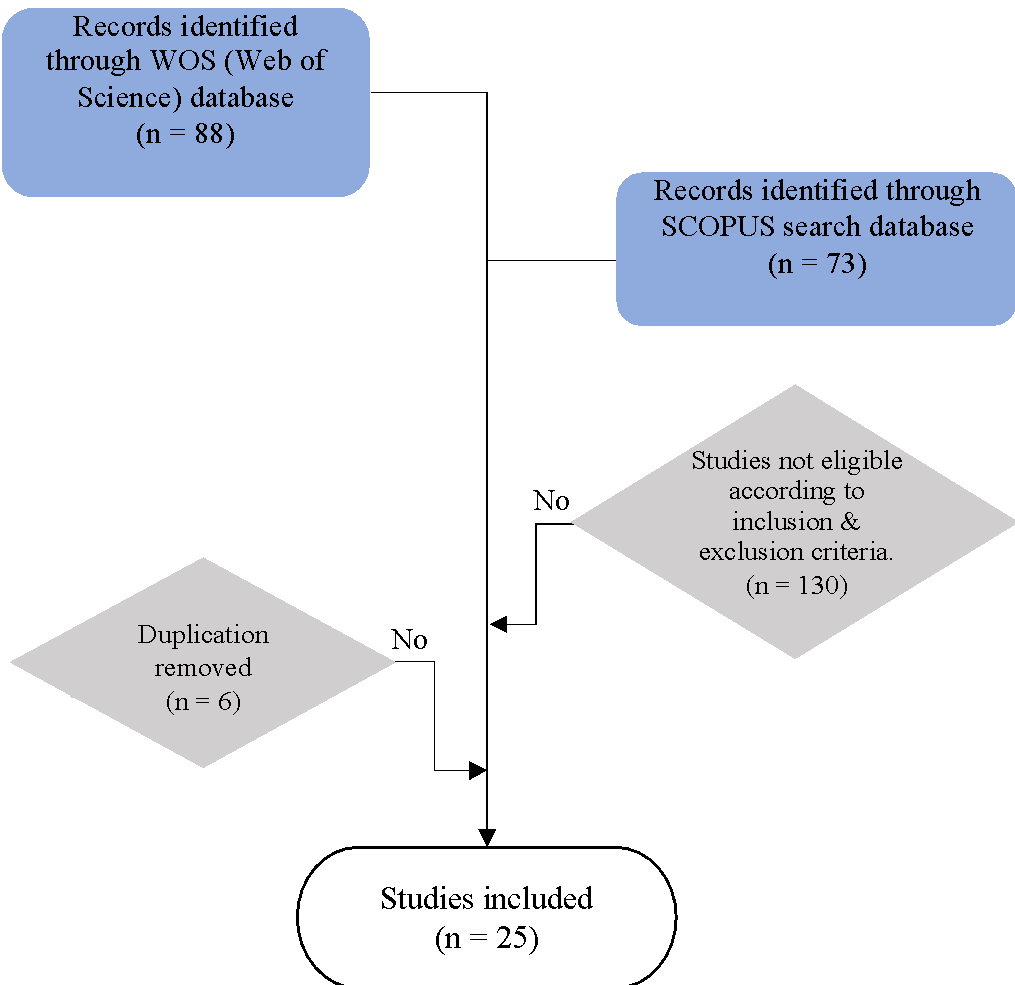
For the purpose of this study, a comprehensive search was performed across a number of databases, such as Web of Science and Scopus, making use of key phrases such as "circular economy" and "SMEs practise." Articles, papers, and documents pertaining to policy that were published between 2019 and 2023 and subjected to peer review were incorporated into the study. The chosen time frame ensures that the review paper includes the most recent and up-to-date research on circular economy practices among SMEs. By focusing on publications from 2019 to 2023, the review paper can provide the most current insights, trends, and developments in this field. The significance of this topic lies in the fact that Geissdoerfer et al. (2017) have highlighted the constantly evolving nature of the circular economy, with ongoing research continuously emerging to tackle the challenges and potential benefits related with its widespread implementation. The research employed a method known as thematic analysis in order to recognise and investigate the recurring topics and patterns that were discovered in the existing literature.
Next, all data were transferred to ATLAS.ti 23 and created as primary documents. From the medata established in Mendeley, several groupings were initiated automatically in the code group is presented in Figure 2. The classification in ATLAS.ti 23 has made the sorting much easier and systematic. In the first round, 21 initial codes were produced. Later the codes were group into several themes and to answer the research question on “what have been the extent of discussion of SMEs' adoption of circular economy practices in the publications from 2019 – 2023?” contributed to a final of three main categories to answer research questions. The findings of this review will be divided into two parts; Quantitative findings and Qualitative findings. By incorporating both qualitative and quantitative findings, the review paper gains a more benefit from the triangulation of evidence. This integration of approaches enables triangulation of evidence, a process that heightens the validity and reliability of the review's findings (Snippen et al., 2019). Consequently, the review benefits from a more robust and well-rounded analysis of the research topic.

Results and Discussion
Qualitative Findings
Articles Published by Year and Country in CE in SMEs Context
Based on the 25 articles found in WOS and SCOPUS, most articles were published and investigated in European country, as shown in Table 2. The rationale for the circular economy movement in European countries is that CE is an European Union development priority and part of the EU industrial policy, as described by Mazur-Wierzbicka (2021). Transitioning to a more circular economy is critical to the EU’s efforts to create a sustainable, low-carbon, resource-efficient, and competitive economy.
In developing countries, particularly in India, there is a notable concentration of publications on circular economy practices. As specified by Kumar et al. (2020), SMEs play a crucial role in the Indian economy, contributing a significant portion to the country's gross domestic product (GDP) and employment. Recognising the significance of SMEs, there is an increasing emphasis in this sector on promoting sustainable practises and the implementation of CE ideas. As a result, researchers and policymakers are increasingly interested in studying the implementation of circular economy practices among SMEs in India. The five articles from India were thoroughly examined, focusing on the challenges faced by SMEs in the context of India's emerging markets when adopting circular economy practices, the level of adaptability and development of circular economy practices by Indian SMEs within an emerging market context, and the fundamental prerequisites for establishing a circular economy framework within SMEs in India. Figure 3 presents the articles based on country publication. Figure 4 shows Sankey diagram of articles based on country publication.
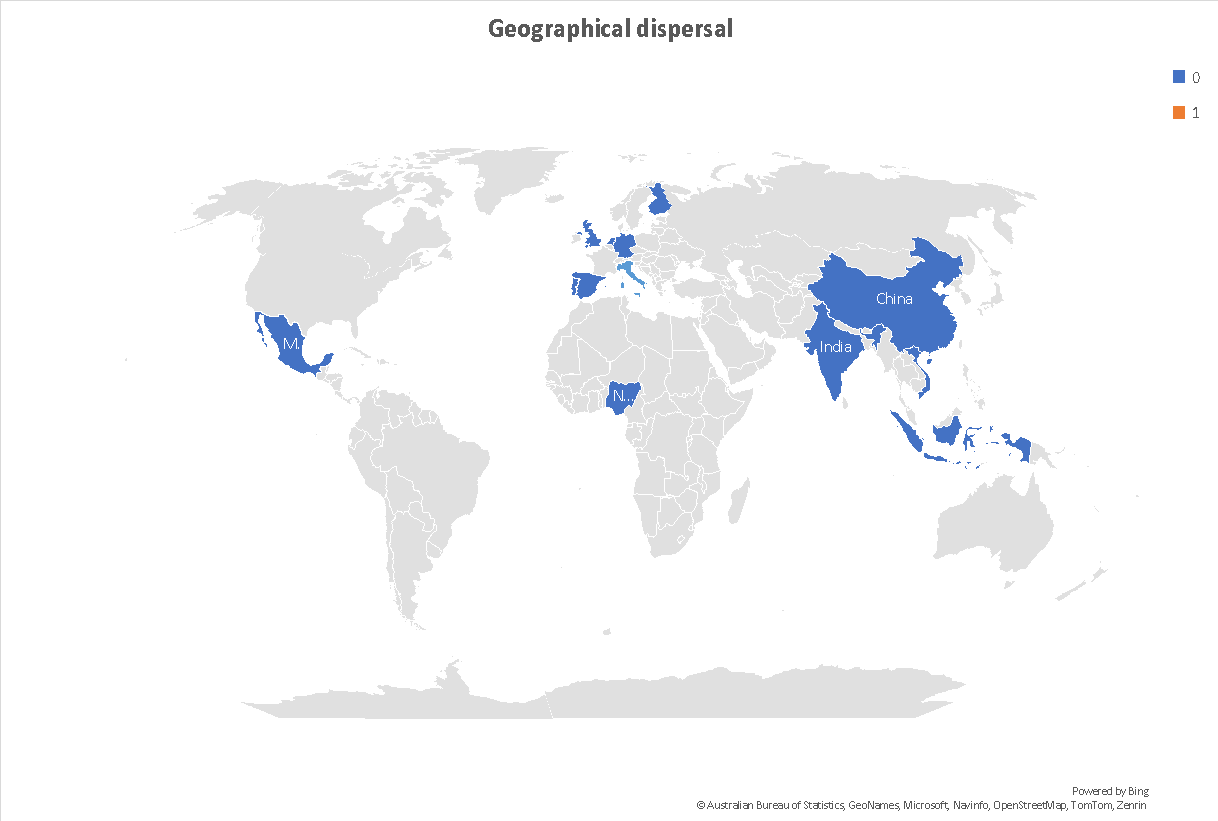
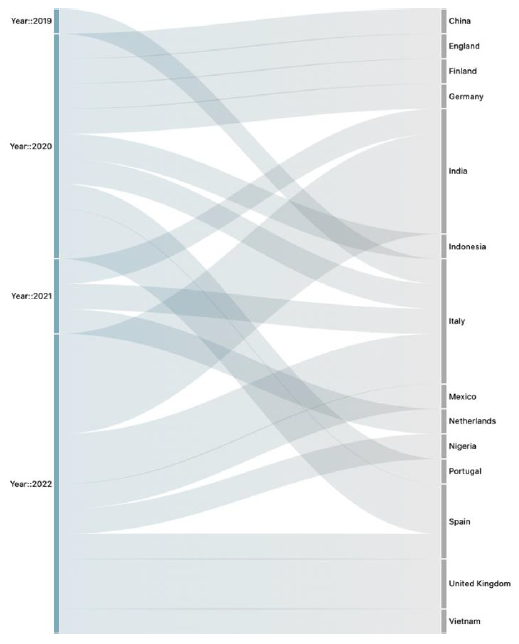
Quantitative Findings
Theme Network
The theme analysis of using ATLAS.ti 23 tool in a literature review was introduced by Zairul (2020). Thematic analysis, according to Clarke and Braun (2013), is the process of detecting patterns and developing themes through extensive reading on a subject. The theme network involves three key themes; drivers and enablers, strategies and practices, and challenges and barriers. These themes are interconnected, as circular economy practices are essential for SMEs to achieve sustainability. Figure 5 presents theme 1 of the study named as drivers and enablers.
Theme 1: Driver and Enablers
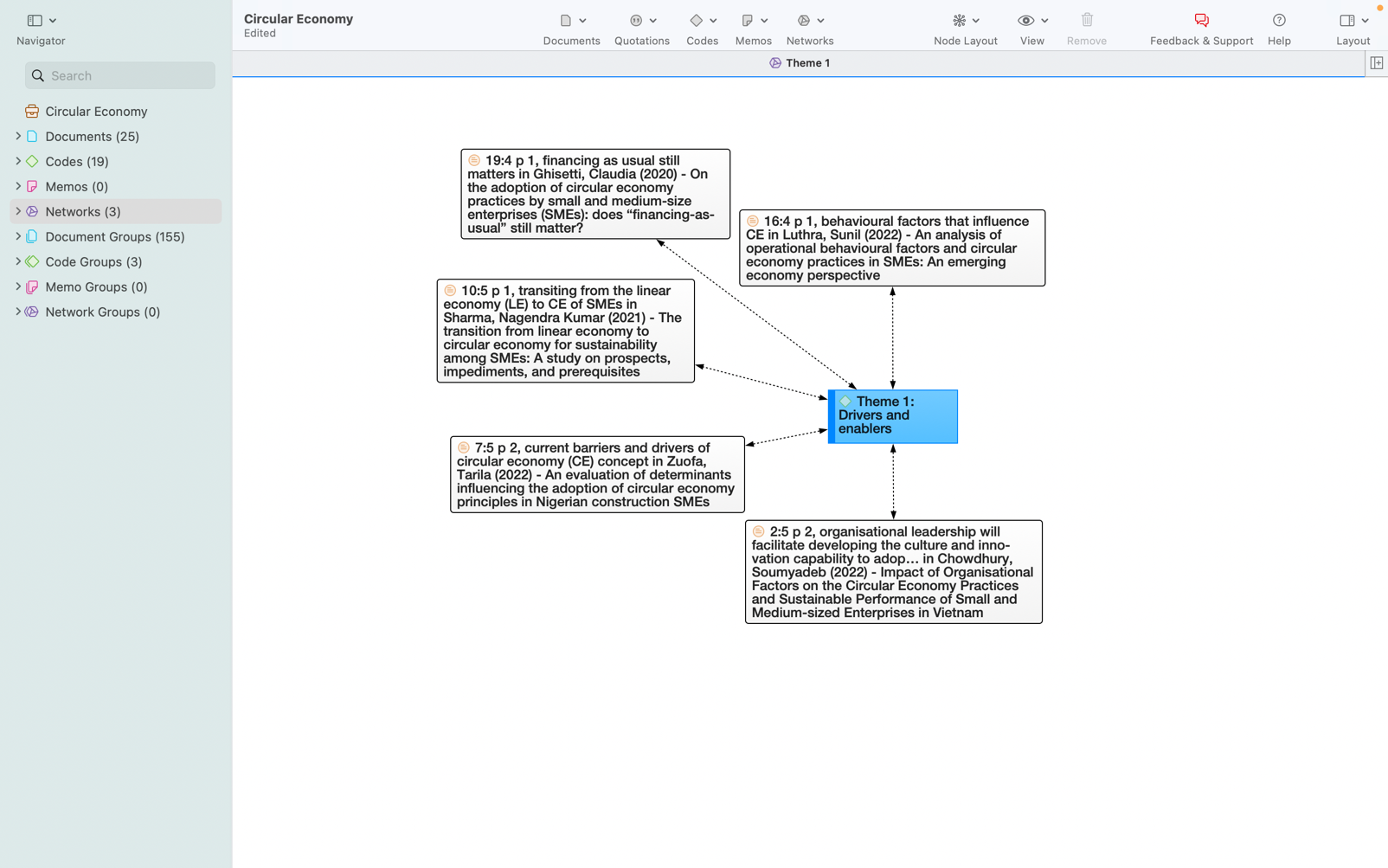
A range of factors have been identified as drivers and enablers of circular economy practices in SMEs. Internal organizational factors such as leadership, innovation, culture, skills, and competencies have been shown to have a positive relationship with both CE practices and sustainable business performance (Chowdhury et al., 2022). However, CE awareness among SME stakeholders in developing countries like Nigeria is still relatively low compared to developed countries, highlighting the need for more education and awareness-raising efforts in these regions (Zuofa et al., 2023). Major requirements for the successful implementation of CE practises include strong managerial will, innovation, technology up-gradation, employee training, encouragement, and proper guidelines (Sharma et al., 2021). The financing of circular economy practises and business models is also crucial, as noted by Ghisetti and Montresor (2020), who discovered that the risks associated with standard financial instruments such as self-capital financing and debt financing in the case of SMEs do not yet inhibit circular economy practises. Lastly, decision-makers and policymakers should analyse the influence of a variety of factors and take action on the identified key causes and effects group variables in order to increase the adoption of CE in SMEs (Luthra et al., 2022).
In a nutshell, the successful implementation of circular economy techniques in SMEs calls for a synergy of leadership, innovation, technological advancement, financial resources, and supportive regulations and guidelines. It is essential for decision-makers to get an understanding of the unique requirements and obstacles that small and medium-sized enterprises (SMEs) encounter when attempting to adopt circular practises and to devise specialised solutions to meet these issues. Figure 6 indicates the theme 2 entitled as strategies and practices.
Theme 2: Strategies and Practises
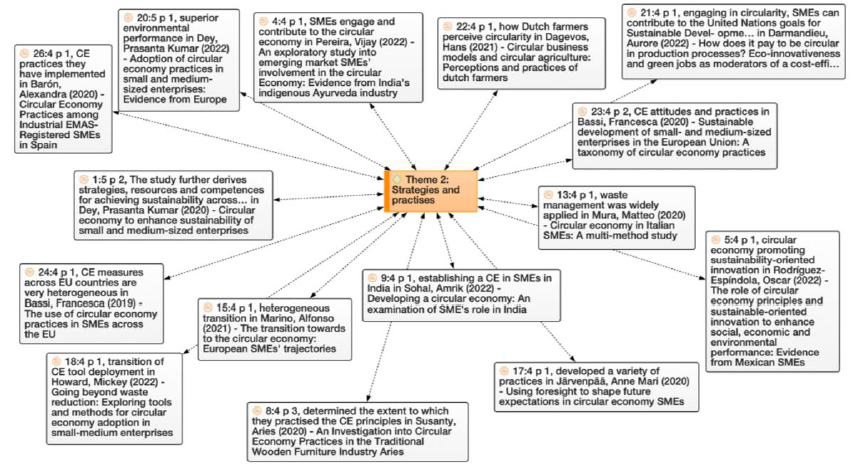
Another theme derived from this analysis is strategies and practises. CE practices in SMEs have become increasingly important, with studies exploring the strategies and practices that can be implemented to achieve greater circularity. Darmandieu et al. (2022) discovered that circularity in processes can reduce manufacturing costs, especially when linked with eco-innovation. Bassi and Dias (2020) presented a taxonomy of EU enterprises and emphasised the need for a deeper knowledge of the elements that influence the decision of SMEs to prioritise sustainability. Mura et al. (2020) identified waste management, packaging, the supply chain, and product/process design as crucial aspects for completing the loop on material flows. Rodríguez-Espíndola et al. (2022) examined the influence of stakeholders, including customer knowledge and expectations, on an organization's participation in sustainable operations. Järvenpää et al. (2020) stressed the significance of foresight efforts for circular economy SME operators. Susanty et al. (2020) indicate that ESCC (Environmental and Social Corporate Citizenship) practises have been implemented inconsistently by SMEs in the Indonesian wooden furniture industry. This difference is attributable to the diversity of CE practises and, by extension, CE-focused performances. In addition, it demonstrates that the adoption of environmentally sustainable and socially responsible practises varies among SMEs, resulting in the classification of SMEs into three groups: leaders, followers, and laggards. Sohal et al. (2022) analysed case studies of SMEs in India and identified prospects for boosting their position within the circular economy.
Marino and Pariso (2021) emphasised the large energy consumption and greenhouse gas emissions attributable to small and medium-sized enterprises (SMEs), as well as the potential for energy-efficient methods to contribute to both cost savings and emissions reduction. Howard et al. (2022) argue that resources and approaches for encouraging circular economy practises must be context-specific in order to avoid becoming prescriptive and disconnected from business reality. Bassi and Dias (2019) note that the majority of CE research focuses on large enterprises and highlight the range of CE activities across European Union SMEs. Dey et al. (2022) report studies on the adoption of CE by SMEs in various countries, indicating that CE could result in enhanced environmental performance, while economic and social performance may vary. Barón et al. (2020) describe circularity practises now employed by SMEs in Catalonia with EMAS regulation, whereas Pereira et al. (2022) explore CE practises in SMEs in emerging market scenarios. As a means of comprehending the role of SMEs in the circular transition, Dagevos and Lauwere (2021) investigate the motives and views of Dutch farmers who contribute to circular agriculture.
Together, these studies show the significance of context-specific approaches and the diversity of CE practises across SMEs, as well as the potential for CE to improve environmental performance while considering economic and social elements of sustainability. The study highlights the complex interaction of factors impacting SMEs' sustainability decisions, ranging from stakeholder expectations and foresight initiatives to energy-efficient procedures and context-specific approaches. Furthermore, the findings highlight the varied landscape of CE implementation among SMEs, allowing these businesses to be classified into separate categories depending on their adoption of environmentally sustainable and socially responsible practises. This distinction between leaders, followers, and laggards emphasises the nuances of circular economy-focused performance and the necessity for specialised tactics to propel advancement. While the majority of CE research has historically focused on larger enterprises, recent studies have shed light on the diverse spectrum of CE activities present across European Union SMEs, highlighting the potential for significant environmental gains as well as varying economic and social performance outcomes. Figure 7 shows the theme 3 named as challenges and barriers.
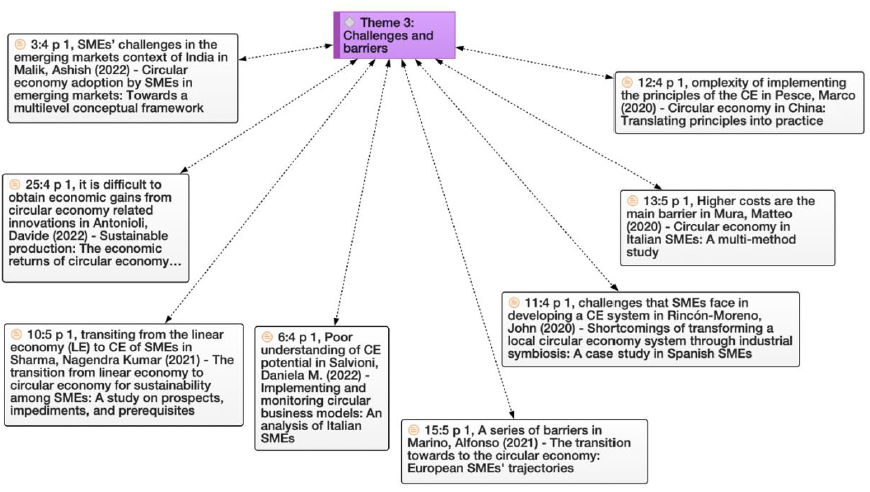
The third theme that has been derived throughout the selected 25 articles is the challenges and barriers present in Figure 7. In accordance with research conducted by Pesce et al. (2020), the implementation of CE principles in SMEs is complicated by the need for support in the form of resources, training, and management's attention, as well as legal issues relating to intellectual property protection and trade secrets, and the potential for harm to the environment. In addition, Mura et al. (2020) emphasise that ambiguous legislation, excessive bureaucracy, a lack of guidelines for SMEs, and the perception of CE as a cost rather than an opportunity are all obstacles to implementation. Rincón-Moreno et al. (2020) believe that connecting stakeholders and technological processes through the use of information systems can help the development of local CE systems; however, individual actors need also be considere. Marino and Pariso (2021) emphasize that certain SME-dominated industries are among the impediments to the transition to CE and advise that government action is required to assist these enterprises. According to Salvioni et al. (2021), inadequate knowledge of CE principles is a prevalent issue among SMEs, which may be exacerbated by risk aversion. In the article by Malik et al. (2022), the authors explore the obstacles that both smaller and larger businesses encounter when trying to execute change, particularly in respect to adopting an approach that is based on a circular economy (CE). The writers argue that cognition, volition, and action are the three primary obstacles that stand in the way of change. To be successful in overcoming these obstacles, you will need strong leadership and the support of your managers, in addition to the formation of new routines, recitals, and rituals. This may require strong collaboration with the local community as well as the identification of a powerful coalition of change champions who are able to exert an effect on other members of the SME's ecosystem. Sharma et al. (2021) underlines the importance of organisational reconfiguration, technological advancement, and knowledge enhancement to assist SMEs in preparing for CE adoption. Pursuant to Antonioli et al. (2022), policies aiming at fostering innovation, such as public funding and procurement, as well as encouraging qualities that favour CE adoption, such as globalisation and collaboration, may assist SMEs in overcoming barriers to CE implementation.
To summarise, in SMEs, circular economy strategies encounter several problems and impediments. Many barriers to the adoption of circular economy activities by SMEs are discussed in the literature, including a lack of support from public institutions, unclear legislation, overbearing bureaucracy, and insufficient knowledge of circular economy ideas. Additional hurdles include the requirement for financial, human resource, training, and management attention, as well as difficulty in implementation without a management structure in place, legal issues, and inconsistent aims among partners. Some of the initiatives that SMEs can take to effectively integrate circular economy strategies include organisational reconfiguration, technology upgrades, and knowledge enhancement. Finally, regulations that encourage innovation and specific characteristics, such as internationalisation, cooperation practises, and networking activities, can make it easier to embrace circular economy technologies. It should also be emphasised that CE awareness is often lower in underdeveloped countries than in industrialised countries, and that implementing circular economy techniques in low-income settings may provide additional issues.
Conclusion
This comprehensive review's findings reveal a significant and growing interest in implementing circular economy practises by SMEs between 2019 and 2023. According to the qualitative study, publications on the subject were distributed throughout various countries, with a noticeable concentration of talks in emerging countries, particularly India. These articles have helped to shed light on the obstacles and potential for SMEs in emerging economies to implement circular economy practises. The quantitative findings, organised into three major themes: drivers and enablers, strategies and practises, and challenges and barriers, provide essential insights into the factors impacting the application of circular economy practises among SMEs. The identification of internal organisational variables as major drivers, such as leadership, innovation, culture, skills, and competencies, emphasises the necessity of cultivating a favourable climate inside SMEs for successful circular economy integration.
Furthermore, an examination of strategies and practises reveals that SMEs are becoming more aware of the potential benefits of circularity, with a focus on eco-innovation, waste management, supply chain optimisation, and product/process redesign. While many SMEs have begun to employ efficiency-based green practises, more attention is still needed on product redesign and circular product life cycles. The examination of challenges and barriers highlights the complexities that SMEs encounter while adopting circular economy practises. Ambiguous legislation, bureaucratic roadblocks, a lack of understanding of circular economy principles, and resource restrictions emerge as important barriers that require tailored interventions to assist adoption. Overall, this theme review paper emphasises the importance of circular economy practises for the long-term viability of SMEs and emphasises the need for comprehensive and context-specific methods to assist their successful integration. Policymakers, business leaders, and stakeholders should work together to build an enabling ecosystem that fosters innovation, improves knowledge dissemination, and provides financial and regulatory support, allowing SMEs to fully realise the potential of circular economy practises and contribute to a more sustainable future. The findings of this study add to the growing body of literature on the circular economy and SMEs, paving the way for additional research and discovery on this critical topic.
Acknowledgments
This research project received funding from the Faculty of Accountancy at Universiti Teknologi MARA, Malaysia, under Grant No. 600-TNCPI 5/3/DDF (AKAUN) (002/2022).
References
Alhawari, O., Awan, U., Bhutta, M. K. S., & Ülkü, M. A. (2021). Insights from Circular Economy Literature: A Review of Extant Definitions and Unravelling Paths to Future Research. Sustainability, 13(2), 859. https://doi.org/10.3390/su13020859
Antonioli, D., Ghisetti, C., Mazzanti, M., & Nicolli, F. (2022). Sustainable production: The economic returns of Circular Economy Practices. Business Strategy and the Environment, 31(5), 2603–2617. https://doi.org/10.1002/bse.3046
Barón, A., de Castro, R., & Giménez, G. (2020). Circular economy practices among industrial emas-registered smes in Spain. Sustainability, 12(21), 9011. https://doi.org/10.3390/su12219011
Bassi, F., & Dias, J. G. (2019). The use of circular economy practices in smes across the EU. Resources, Conservation and Recycling, 146, 523–533. https://doi.org/10.1016/j.resconrec.2019.03.019
Bassi, F., & Dias, J. G. (2020). Sustainable development of small‐ and medium‐sized enterprises in the European Union: A taxonomy of circular economy practices. Business Strategy and the Environment, 29(6), 2528–2541. https://doi.org/10.1002/bse.2518
Bocken, N. M. P., de Pauw, I., Bakker, C., & van der Grinten, B. (2016). Product design and business model strategies for a circular economy. Journal of Industrial and Production Engineering, 33(5), 308-320.
Chowdhury, S., Dey, P. K., Rodríguez-Espíndola, O., Parkes, G., Tuyet, N. T. A., Long, D. D., & Ha, T. P. (2022). Impact of Organisational Factors on the Circular Economy Practices and Sustainable Performance of Small and Medium-sized Enterprises in Vietnam. Journal of Business Research, 147, 362-378. https://doi.org/10.1016/j.jbusres.2022.03.077
Clarke, V., & Braun, V. (2013). Teaching thematic analysis: Overcoming challenges and developing strategies for effective learning. The Psychologist, 26(2), 120–123. https://doi.org/doi.org/10.4135/9781412963909.n451
Dagevos, H., & Lauwere, C. D. (2021). Circular business models and circular agriculture: Perceptions and practices of Dutch farmers. Sustainability, 13(3), 1282. https://doi.org/10.3390/su13031282
Darmandieu, A., Garcés-Ayerbe, C., Renucci, A., & Rivera-Torres, P. (2022). How does it pay to be circular in production processes? Eco-innovativeness and green jobs as moderators of a cost-efficiency advantage in European small and medium enterprises. Business Strategy and the Environment, 31(3), 1184-1203. https://doi.org/10.1002/bse.2949
Demirel, P., & Danisman, G. O. (2019). Eco‐innovation and firm growth in the Circular Economy: Evidence from European small‐ and medium‐sized enterprises. Business Strategy and the Environment, 28(8), 1608–1618. https://doi.org/10.1002/bse.2336
Dey, P. K., Malesios, C., Chowdhury, S., Saha, K., Budhwar, P., & De, D. (2022). Adoption of circular economy practices in small and medium-sized enterprises: Evidence from Europe. International Journal of Production Economics, 248, 108496.
Geissdoerfer, M., Savaget, P., Bocken, N. M. P., & Hultink, E. J. (2017). The circular economy – a new sustainability paradigm? Journal of Cleaner Production, 143, 757–768. https://doi.org/10.1016/j.jclepro.2016.12.048
Ghisetti, C., & Montresor, S. (2020). On the adoption of circular economy practices by small and medium-size enterprises (SMEs): does "financing-as-usual" still matter? Journal of Evolutionary Economics, 30(2), 559-586. https://doi.org/10.1007/s00191-019-00651-w
Howard, M., Yan, X., Mustafee, N., Charnley, F., Böhm, S., & Pascucci, S. (2022). Going beyond waste reduction: Exploring tools and methods for circular economy adoption in small-medium enterprises. Resources, Conservation and Recycling, 182, 106345. https://doi.org/10.1016/j.resconrec.2022.106345
Invernizzi, D. C., Locatelli, G., Velenturf, A., Love, P. E., Purnell, P., & Brookes, N. J. (2020). Developing policies for the end-of-life of energy infrastructure: Coming to terms with the challenges of decommissioning. Energy Policy, 144, 111677. https://doi.org/10.1016/j.enpol.2020.111677
Järvenpää, A.-M., Kunttu, I., & Mäntyneva, M. (2020). Using foresight to shape future expectations in circular economy smes. Technology Innovation Management Review, 10(7), 41–50. https://doi.org/10.22215/timreview/1374
Korhonen, J., Honkasalo, A., & Seppälä, J. (2018). Circular economy: The concept and its limitations. Ecological Economics, 143, 37–46. https://doi.org/10.1016/j.ecolecon.2017.06.041
Kumar, R., Singh, R. K., & Dwivedi, Y. K. (2020). Application of industry 4.0 technologies in SMEs for ethical and sustainable operations: Analysis of challenges. Journal of Cleaner Production, 275, 124063. https://doi.org/10.1016/j.jclepro.2020.124063
Luthra, S., Kumar, A., Sharma, M., Arturo Garza-Reyes, J., & Kumar, V. (2022). An analysis of operational behavioural factors and circular economy practices in smes: An emerging economy perspective. Journal of Business Research, 141, 321–336. https://doi.org/10.1016/j.jbusres.2021.12.014
MacArthur, E. (2013). Towards the circular economy. economic and business rationale for an accelerated transition. Ellen MacArthur Foundation, Cowes.
Malik, A., Sharma, P., Sharma, P., Vinu, A., Karakoti, A., Kaur, K., Gujral, H. S., Munjal, S., & Laker, B. (2022). Circular economy adoption by smes in emerging markets: Towards a multilevel Conceptual Framework. Journal of Business Research, 142, 605–619. https://doi.org/10.1016/j.jbusres.2021.12.076
Marco-Fondevila, M., Llena-Macarulla, F., Callao-Gastón, S., & Jarne-Jarne, J. I. (2021). Are circular economy policies actually reaching organizations? evidence from the largest Spanish companies. Journal of Cleaner Production, 285, 124858. https://doi.org/10.1016/j.jclepro.2020.124858
Marino, A., & Pariso, P. (2021). The transition towards to the circular economy: European smes' trajectories. Entrepreneurship and Sustainability Issues, 8(4), 431–455. https://doi.org/10.9770/jesi.2021.8.4(26)
Mazur-Wierzbicka, E. (2021). Circular economy: Advancement of european union countries. Environmental Sciences Europe, 33(1). https://doi.org/10.1186/s12302-021-00549-0
Mura, M., Longo, M., & Zanni, S. (2020). Circular economy in Italian smes: A multi-method study. Journal of Cleaner Production, 245, 118821. https://doi.org/10.1016/j.jclepro.2019.118821
Oncioiu, I., Căpuşneanu, S., Türkeș, M., Topor, D., Constantin, D.-M., Marin-Pantelescu, A., & Ștefan Hint, M. (2018). The Sustainability of Romanian SMEs and Their Involvement in the Circular Economy. Sustainability, 10(8), 2761. https://doi.org/10.3390/su10082761
Pereira, V., Nandakumar, M. K., Sahasranamam, S., Bamel, U., Malik, A., & Temouri, Y. (2022). An exploratory study into emerging market smes’ involvement in the circular economy: Evidence from India’s indigenous ayurveda industry. Journal of Business Research, 142, 188–199. https://doi.org/10.1016/j.jbusres.2021.12.053
Pesce, M., Tamai, I., Guo, D., Critto, A., Brombal, D., Wang, X., Cheng, H., & Marcomini, A. (2020). Circular economy in China: Translating principles into practice. Sustainability, 12(3), 832. https://doi.org/10.3390/su12030832
Pratt, K., Lenaghan, M., & Mitchard, E. T. A. (2016). Material flows accounting for Scotland shows the merits of a circular economy and the folly of territorial carbon reporting. Carbon Balance and Management, 11(1).
Rincón-Moreno, J., Ormazabal, M., Álvarez, M. J., & Jaca, C. (2020). Shortcomings of transforming a local circular economy system through industrial symbiosis: A case study in Spanish smes. Sustainability, 12(20), 8423. https://doi.org/10.3390/su12208423
Rizos, V., Behrens, A., van der Gaast, W., Hofman, E., Ioannou, A., Kafyeke, T., Flamos, A., Rinaldi, R., Papadelis, S., Hirschnitz-Garbers, M., & Topi, C. (2016). Implementation of circular economy business models by small and medium-sized enterprises (smes): Barriers and enablers. Sustainability, 8(11), 1212. https://doi.org/10.3390/su8111212
Rodríguez-Espíndola, O., Cuevas-Romo, A., Chowdhury, S., Díaz-Acevedo, N., Albores, P., Despoudi, S., Malesios, C., & Dey, P. (2022). The role of circular economy principles and sustainable-oriented innovation to enhance social, economic and environmental performance: Evidence from Mexican Smes. International Journal of Production Economics, 248, 108495. https://doi.org/10.1016/j.ijpe.2022.108495
Salvioni, D. M., Bosetti, L., & Fornasari, T. (2021). Implementing and monitoring circular business models: An analysis of Italian smes. Sustainability, 14(1), 270. https://doi.org/10.3390/su14010270
Sharma, N. K., Govindan, K., Lai, K. K., Chen, W. K., & Kumar, V. (2021). The transition from linear economy to circular economy for sustainability among SMEs: A study on prospects, impediments, and prerequisites. Business Strategy and the Environment, 30(4), 1803-1822. https://doi.org/10.1002/bse.2717
Snippen, N. C., de Vries, H. J., van der Burg-Vermeulen, S. J., Hagedoorn, M., & Brouwer, S. (2019). Influence of significant others on work participation of individuals with chronic diseases: a systematic review. BMJ Open, 9(1), e021742. https://doi.org/10.1136/bmjopen-2018-021742
Sohal, A., Nand, A. A., Goyal, P., & Bhattacharya, A. (2022). Developing a circular economy: An examination of SME’s role in India. Journal of Business Research, 142, 435–447. https://doi.org/10.1016/j.jbusres.2021.12.072
Stahel, W. R., & MacArthur, E. (2019). The Circular Economy: A User's Guide. Routledge, Taylor & Francis Group.
Susanty, A., Tjahjono, B., & Sulistyani, R. E. (2020). An investigation into circular economy practices in the traditional wooden furniture industry. Production Planning & Control, 31(16), 1336–1348. https://doi.org/10.1080/09537287.2019.1707322
Zairul, M. (2020). A thematic review on student-centred learning in the studio education. Journal of Critical Reviews, 7(02). https://doi.org/10.31838/jcr.07.02.95
Zairul, M. (2021). A thematic review on industrialised building system (IBS) publications from 2015-2019: Analysis of patterns and trends for future studies of IBS in Malaysia. Pertanika Journal of Social Sciences and Humanities, 29(1). https://doi.org/10.47836/pjssh.29.1.35
Zuofa, T., Ochieng, E. G., & Ode-Ichakpa, I. (2023). An evaluation of determinants influencing the adoption of circular economy principles in Nigerian construction SMEs. Building Research & Information, 51(1), 69-84. https://doi.org/10.1080/09613218.2022.2142496
Copyright information

This work is licensed under a Creative Commons Attribution-NonCommercial-NoDerivatives 4.0 International License.
About this article
Publication Date
15 November 2023
Article Doi
eBook ISBN
978-1-80296-130-0
Publisher
European Publisher
Volume
131
Print ISBN (optional)
-
Edition Number
1st Edition
Pages
1-1281
Subjects
Technology advancement, humanities, management, sustainability, business
Cite this article as:
Kamal, L. N., & Jasni, N. S. (2023). A Thematic Review on Circular Economy Practices Among SMEs. In J. Said, D. Daud, N. Erum, N. B. Zakaria, S. Zolkaflil, & N. Yahya (Eds.), Building a Sustainable Future: Fostering Synergy Between Technology, Business and Humanity, vol 131. European Proceedings of Social and Behavioural Sciences (pp. 1096-1110). European Publisher. https://doi.org/10.15405/epsbs.2023.11.89

